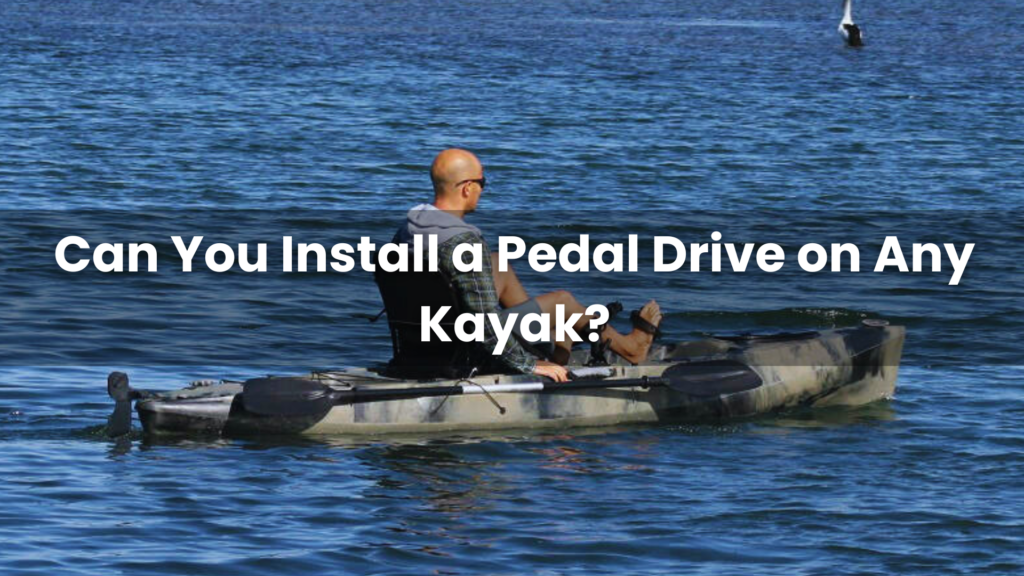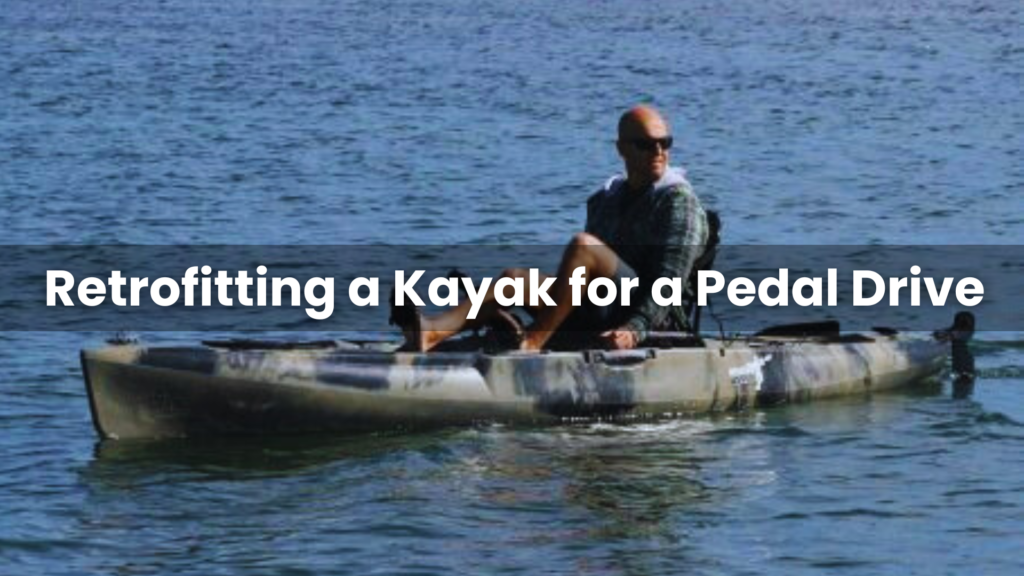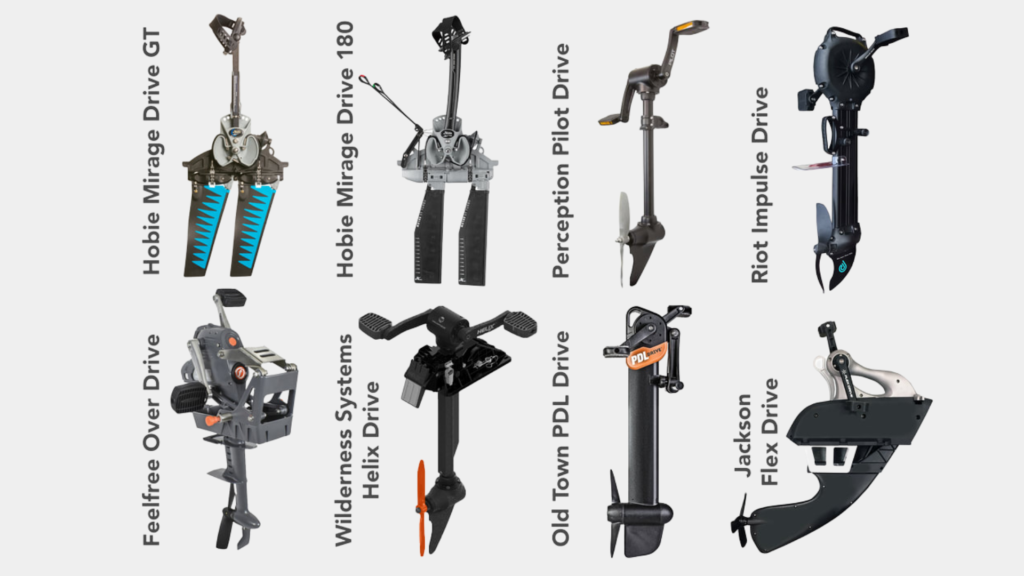Kayaking has become an increasingly popular water activity, offering enthusiasts the opportunity to explore waterways and enjoy the great outdoors. One of the recent innovations that has revolutionized the kayaking experience is the pedal drive system. This mechanism allows kayakers to propel their watercraft using foot pedals, providing benefits such as increased speed, hands-free operation, and improved maneuverability.
A common question that arises among kayakers is, Can you put a pedal drive on any kayak? This is a valid concern, as the compatibility of a kayak with a pedal drive system can vary depending on several factors. In this comprehensive article, we will delve into the intricacies of kayak design, compatibility considerations, and the process of retrofitting a kayak to accommodate a pedal drive system. We’ll also explore alternative propulsion options for kayaks that may not be suitable for a pedal drive.
Can You Install a Pedal Drive on Any Kayak?

When it comes to installing a pedal drive on a kayak, the answer is not a straightforward yes for every kayak model. Several factors come into play when determining the compatibility of a kayak with a pedal drive system. One of the primary considerations is the hull design of the kayak. Kayaks with a flat bottom are generally more suitable for pedal drives, as they provide a stable platform for mounting the system. In contrast, kayaks with a rounded hull may not offer the necessary stability or mounting points for a pedal drive.
Another crucial factor to consider is the size and weight capacity of the kayak. Pedal drives add weight to the kayak, so it’s essential to ensure that your kayak can support the additional load without compromising its performance or safety. Additionally, the availability of mounting points on the kayak is vital for securely attaching the pedal drive system. Sit-on-top kayaks, recreational kayaks, and fishing kayaks are often compatible with pedal drives due to their design features, while inflatable, touring, and whitewater kayaks may not be suitable for retrofitting a pedal drive.
Stay tuned for the next section where we will explore how to determine if your kayak is compatible with a pedal drive system.
How to Determine if Your Kayak is Compatible

To assess whether your kayak can accommodate a pedal drive system, there are several steps you can take to ensure a proper fit and installation. Here’s a guide to help you determine the compatibility of your kayak with a pedal drive:
Check the manufacturer’s specifications: Start by reviewing the manufacturer’s guidelines and recommendations for your kayak model. Manufacturers often provide information on compatibility with aftermarket accessories like pedal drives.
Measure the kayak’s dimensions: Take measurements of your kayak’s length, width, and weight capacity to determine if it can support the additional weight of a pedal drive system. Ensure that the kayak has sufficient space and structural integrity to accommodate the system.
Inspect the hull design: Examine the hull of your kayak to identify any flat areas or mounting points where a pedal drive can be installed. Flat-bottomed kayaks are generally more conducive to mounting pedal drives compared to kayaks with a rounded hull.
Research pedal drive models: Look into different pedal drive systems available in the market and their installation requirements. Consider factors like pedal system design, mounting hardware, and compatibility with your kayak’s structure.
Retrofitting a Kayak for a Pedal Drive

If your kayak is compatible with a pedal drive system, you may consider retrofitting it to enjoy the benefits of hands-free propulsion. Retrofitting a kayak involves modifying its structure to accommodate the pedal drive system securely. Here are some key considerations and steps involved in retrofitting a kayak for a pedal drive:
Drilling holes for mounting: Depending on the pedal drive system you choose, you may need to drill holes in your kayak to attach the mounting hardware securely. It’s essential to follow the manufacturer’s instructions and use proper tools to ensure a precise and secure fit.
Reinforcing the kayak: Adding a pedal drive system increases the weight and stress on your kayak. To prevent damage and ensure stability, consider reinforcing the kayak’s structure with additional support or reinforcement materials. This step is crucial for maintaining the integrity of your kayak while using a pedal drive.
Routing cables and hoses: Pedal drive systems often come with cables and hoses that need to be connected to the kayak’s steering mechanism and propeller. Properly routing these components and securing them in place is essential for smooth operation and longevity of the system.
Retrofitting a kayak for a pedal drive requires attention to detail and precision to ensure a safe and effective installation. If you’re not confident in your DIY skills, consider seeking professional assistance to retrofit your kayak or consult with experienced kayakers for guidance.
Alternatives to Pedal Drives

While pedal drives offer a convenient and efficient way to propel a kayak, not all kayaks are compatible with this propulsion system. If your kayak is not suitable for a pedal drive or if you prefer alternative propulsion methods, there are several options to consider:
Oar-powered kayaks: Traditional oars provide a reliable and versatile means of propulsion for kayaks. Oar-powered kayaks offer excellent control and maneuverability, making them suitable for various water conditions.
Electric trolling motors: Electric trolling motors are another popular choice for powering kayaks, especially for anglers looking for a quiet and efficient propulsion method. Trolling motors offer adjustable speeds and hands-free operation, similar to pedal drives.
Paddle-powered kayaks: The classic paddle remains a versatile and effective means of propelling a kayak. Paddle-powered kayaks offer simplicity, maneuverability, and a great workout for kayakers looking to stay active on the water.
Each propulsion method has its advantages and considerations, so choose the option that best suits your kayaking style, preferences, and the type of water you’ll be navigating.
Conclusion
In conclusion, the question Can you put a pedal drive on any kayak? does not have a simple yes or no answer. The compatibility of a kayak with a pedal drive system depends on various factors, including the hull design, size, weight capacity, and availability of suitable mounting points.
Through our exploration of this topic, we’ve learned that while not every kayak can accommodate a pedal drive, with careful assessment and the right retrofitting approach, it is possible to enhance your kayaking experience with this innovative propulsion system. Sit-on-top, recreational, and fishing kayaks are generally more compatible with pedal drives, while inflatable, touring, and whitewater kayaks may present more challenges.
When considering whether to add a pedal drive to your Can You Put a Pedal Drive on Any Kayak, it’s essential to prioritize safety, proper installation, and compatibility. Thoroughly evaluate your kayak’s specifications, research pedal drive models, and, if necessary, seek professional assistance to ensure a secure and effective retrofitting process.
If your kayak is not suitable for a pedal drive or if you prefer alternative propulsion methods, there are other options to consider, such as oar-powered kayaks, electric trolling motors, and traditional paddle-powered kayaks. Each propulsion method has its own advantages, so choose the one that best aligns with your kayaking style, preferences, and the water conditions you’ll be navigating.
Ultimately, the decision to add a pedal drive to your kayak should be based on a careful assessment of your kayak’s compatibility and your personal needs and preferences. By understanding the factors involved, you can make an informed choice and enhance your kayaking adventures on the water.
FAQs about Can You Put a Pedal Drive on Any Kayak
Is it possible to install a pedal drive on any kayak?
While it may be theoretically possible to install a pedal drive on any kayak, practicality and compatibility play significant roles. Factors like hull design, size, and mounting points determine if a kayak can effectively accommodate a pedal drive system.
What should I consider when looking to add a pedal drive to my kayak?
When considering adding a pedal drive to your kayak, factors to evaluate include the kayak’s hull shape, weight capacity, availability of mounting points, and the feasibility of retrofitting the kayak to support the pedal drive system securely.
Are there specific kayak types that are more suitable for pedal drives?
Yes, certain kayak types like sit-on-top, recreational, and fishing kayaks are generally more compatible with pedal drives due to their design features and stability. In contrast, inflatable, touring, and whitewater kayaks may not be ideal for retrofitting a pedal drive.
Can I retrofit my kayak for a pedal drive system?
Retrofitting a kayak for a pedal drive involves modifications like drilling holes for mounting, reinforcing the kayak’s structure, and routing cables and hoses. It’s essential to ensure a secure and precise installation to maintain the kayak’s integrity and performance.
What are the alternatives to pedal drives for kayaks?
If a kayak is not suitable for a pedal drive or if you prefer other propulsion methods, alternatives like oar-powered kayaks, electric trolling motors, and traditional paddles offer viable options for propelling your kayak.
How can I determine if my kayak is compatible with a pedal drive system?
To assess compatibility, check the manufacturer’s specifications, measure the kayak’s dimensions and weight capacity, inspect the hull design for mounting points, and research pedal drive models to understand installation requirements.
What are the practical considerations when deciding to add a pedal drive to a kayak?
Practical considerations include the cost and effort involved in retrofitting a kayak, the impact on the kayak’s performance and stability, and the availability of professional assistance if needed. It’s essential to weigh these factors before deciding to add a pedal drive to your kayak.

Nigel Foster, born in 1952, is an esteemed sea kayaker, known for being the youngest to kayak around Iceland. His journey in kayaking started at 15 in Brighton, England. With a career beginning as a trainee instructor in Sussex, he later pursued teaching after attending Redland College, Bristol.
Foster’s notable expeditions include navigating the challenging waters of Newfoundland and the Hudson Strait. Despite facing intense conditions, his passion for kayaking never waned. He holds several British Canoe Union qualifications and has significantly contributed to the kayaking community through teaching and committee work.
In 1985, Foster expanded his horizons by assisting an expedition in Iceland and later founded his own kayaking business, sharing his expertise globally.
